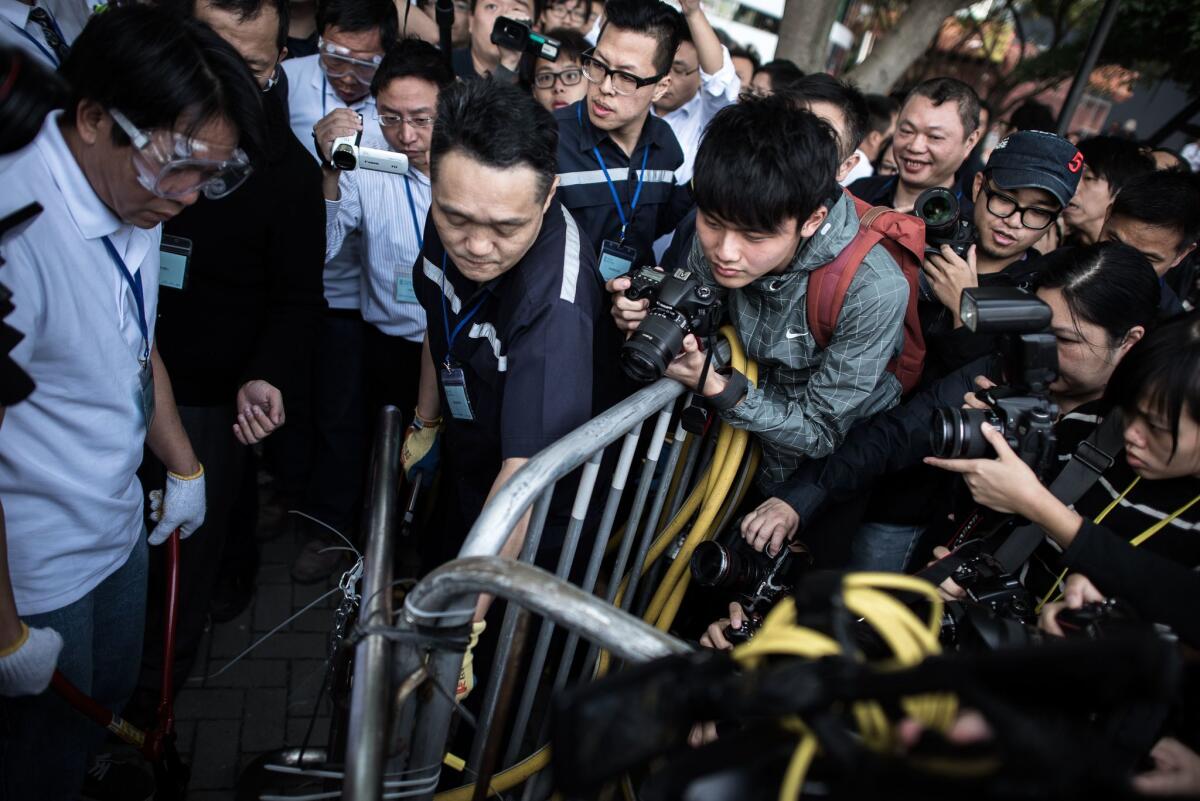Masked men set off clashes with police in Hong Kong

- Share via
Reporting from Hong Kong — Using a metal barricade as a battering ram, masked men smashed through a window at Hong Kong’s Legislative Council headquarters early Wednesday, setting off clashes with police and raising fears that the government would step in with decisive action to clear the streets of pro-democracy protesters.
Four men between the ages of 18 and 24 were arrested on charges of criminal damage and assaulting an officer, police said. Three officers sustained injuries and were treated at a hospital.
Police said around 1 a.m. the crowd repeatedly charged their cordon line, prompting officers to use pepper spray “and defend against attack.”
Lawmaker Paul Zimmerman denounced the attempted break-in. “Radicals and provocateurs,” he said on his Facebook page, had shattered the stalemate between democracy demonstrators and authorities, giving the government “a great excuse for its intransigence, lack of dialogue and more fences.”
“Instead of leaving on a high, instead of a slow winding down under court orders, it may all end with violence,” he said. Hong Kong, he said, had “stood against tear gas, and will certainly stand against property damage and riots. Whoever is behind this, this is to be condemned by all.”
Lawmaker Fernando Cheung arrived on the scene and attempted to dissuade the young men from breaking the window.
The incident at the legislative complex happened just around the corner from an area where on Tuesday a team of security guards and janitors, assisted by court bailiffs, began removing barricades erected by pro-democracy protesters after a court authorized the operation.
About two dozen demonstrators were occupying the streets around Citic Tower in the Admiralty district near Hong Kong government headquarters. Bailiffs and a legal representative for the office building used loudspeakers to announce their intention to begin clearing the roadway about 9:30 a.m.
Protesters voluntarily packed up some tents and other belongings. However, a standoff ensued after about half an hour, with demonstrator Kok Sui-kit, a member of the Labor Party, challenging the bailiffs and cleaning crews over details of the boundary of the clearance zone.
The standoff was resolved when a local legislator, Albert Ho, arrived and negotiated with a lawyer representing Citic Tower.
The court injunction was issued at the request of Goldon Investment, a joint-venture company controlled by Citic Group, which owns the 33-story building. Citic Group is a Chinese-government-owned conglomerate with interests in financial services, resources and energy, manufacturing, real estate and infrastructure, engineering contracting and other sectors.
The court ruling by Justice Thomas Au said protesters had blocked the entrance to the Citic Tower parking garage and two fire exits, presenting a danger to occupants. Au added that the blockade had also cost the company lost parking revenues.
At least a dozen plainclothes police and other officers observed the operation, and were authorized by the court to assist the bailiffs if needed. Police released a statement warning that officers would take “resolute action” against anyone who obstructed or “violently charges” those involved in the clearance operation.
After the street in front of the office tower was reopened, several dozen protesters entered the lobby of the building.
Hong Kong legislator Lee Cheuk-yan addressed the gathering, calling on the government to resume a dialogue with student leaders of the protests.
“The government should not hide behind a court order,” Lee said. “We want to negotiate with the government, not the police.”
Protesters took to the streets in late September, angered over guidelines for Hong Kong’s 2017 chief executive election. The demonstrators say the framework, issued by mainland Chinese authorities, does not allow for free nomination of candidates in the election.
One round of discussions between Hong Kong officials and representatives of the Hong Kong Federation of Students last month resulted in no progress in resolving the standoff.
Hong Kong and mainland Chinese officials have denounced the protests as illegal.
After drawing massive crowds to the streets in late September and early October, the protests have diminished substantially in size, though a core group of demonstrators remain encamped in Admiralty as well as in the Mong Kok and Causeway Bay neighborhoods.
A poll conducted last week by the Chinese University of Hong Kong found that public support for the protests has waned. More than 43% of respondents said they did not support the movement, up from 35% in October. Some 34% of respondents said they still supported the movement. But about 70% of respondents said it was time for protesters to leave the streets.
Alvin Lau, a 22-year-old student who had slept in a tent overnight at the site being cleared Tuesday, vowed to keep participating in the sit-ins. “I’m just going to move to a different spot” in the occupied area, he said.
Special correspondent Law reported from Hong Kong and Times staff writer Makinen from Beijing. Sean Silbert in The Times’ Beijing bureau contributed to this report.
Follow @JulieMakLAT for news from China
More to Read
Sign up for Essential California
The most important California stories and recommendations in your inbox every morning.
You may occasionally receive promotional content from the Los Angeles Times.














